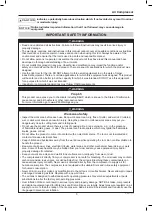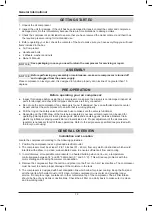
6
General International
WARNING
Personal Safety
•
Stay alert, watch what you are doing, and use common sense when operating the tool. Do not use the
tool while you are tired or under the influence of drugs, alcohol, or medication. A moment of inattention
while operating the tool may result in serious personal injury.
•
Dress properly. Do not wear loose clothing, dangling objects, or jewelry. Keep your hair, clothing and
gloves away from moving parts. Loose clothes, jewelry, or long hair can be caught in moving parts. Air
vents on the tool often cover moving parts and should be avoided.
•
Wear the proper personal protective equipment when necessary. Use ANSI Z87.1 compliant safety
goggles (not safety glasses) with side shields, or when needed, a face shield. Use a dust mask in dusty
work conditions. Also use non-skid safety shoes, hardhat, gloves, dust collection systems, and hearing
protection when appropriate. This applies to all persons in the work area.
• Work in an area with good cross ventilation. Read and follow the safety instructions provided on the
label or safety data sheets for the materials you are spraying. Always use certified safety equipment:
NIOSH/OSHA respiratory protection or properly fit ting face mask designed for use with your specific
application.
• Do not overreach. Keep proper footing and balance at all times.
•
Remove keys or wrenches before connecting the tool to an air supply, power supply, or turning on the
tool. A wrench or key that is left attached to a rotating part of the tool may cause personal injury.
• Secure the work with clamps or a vise instead of your hand when practical. This safety precaution allows
for proper tool operation using both hands.
• Never touch any exposed metal parts on compressor during or immediately after operation. The
compressor will remain hot for several minutes after operation. Do not reach around protective shrouds
or attempt maintenance until the unit has been allowed to cool.
•
The compressed air stream can cause soft tissue damage to exposed skin and can propel dirt, chips,
loose particles and small objects at high speed, resulting in property damage or personal injury. Never
point any nozzle or sprayer toward any part of the body or at other people or animals.
CAUTION
Air Compressor Use And Care
• Do not force the air compressor. Products are safer and do a better job when used in the manner for
which they are designed. Plan your work and use the correct product for the job.
• Check for damaged parts before each use. Carefully check that the product will operate properly and
perform its intended function. Replace damaged or worn parts immediately. Never operate the product
with a damaged part.
• Do not use a product with a malfunctioning switch. Any power tool that cannot be controlled with the
power switch is dangerous and must be repaired by an authorized service representative before using.
•
Disconnect the power/air supply from the product and place the switch in the locked or off position
before making any adjustments, changing accessories, or storing the tool. Such preventive safety
measures reduce the risk of starting the tool accidentally.
•
Store the product when it is not in use. Store it in a dry, secure place out of the reach of children. Inspect
the tool for good working condition prior to storage and before re-use.
• Use only accessories that are recommended by the manufacturer for use with your product. Accessories
that may be suitable for one product may create a risk of injury when used with another tool. Never use
an accessory that has a lower operating speed or operating pressure than the tool itself.
• Keep guards in place and in working order. Never operate the product without the guards in place.
• Do not leave the tool running unattended.
•
Drain the moisture from the tank on a daily basis. A clean, dry tank will help prevent corrosion.
•
Pull the pressure relief valve ring daily to ensure that the valve is functioning properly, and to clear the
valve of any possible obstructions.
•
To provide proper ventilation for cooling, the compressor must be kept a minimum of 12 inches (31 cm)
from the nearest wall, in a well–ventilated area.
• Fasten the compressor down securely if transporting is necessary. Pressure must be released from the
tank before transporting.
• Protect the air hose and electric cord from damage and puncture. Inspect them weekly for weak or worn
spots and replace if necessary.
•
To reduce the risk of electric shock, do not expose to rain. Store indoors.
• Never operate the compressor if the power cord or plug are damaged. Take the equipment to the
nearest Authorized Service Center and a specialized technician will replace it.






































